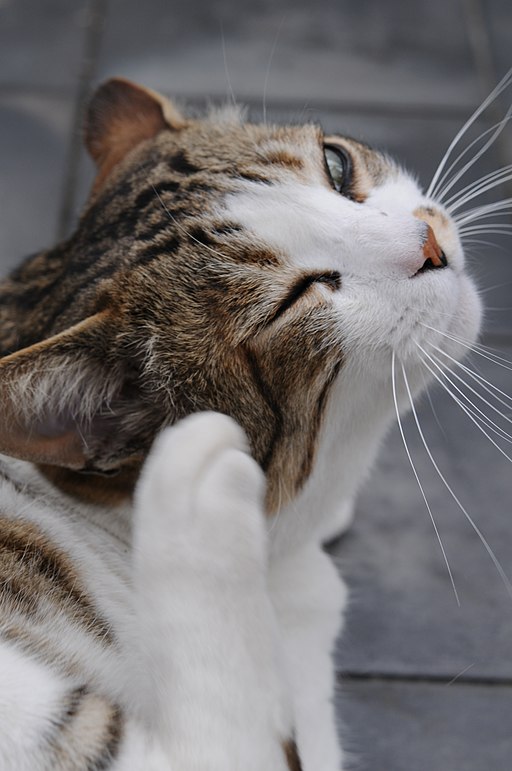For cat owners, as we come toward the back end of spring and into May it is worthwhile remembering that we are entering “Flea” season. As temperatures climb after winter, fleas and other such parasites commonly found on pets become a real issue. We have to be careful to take precautions to make sure our pets and houses don’t get invaded by these dirty little invaders.
The season starts in May and runs through till September by which point frosty temperatures kill off fleas and end their life cycle. In the meantime our pets are usually spending more time outdoors in the better weather and are liable to accidentally pick up these parasites from long grass, hedges and from contact with other cats and dogs. This can be a huge problem as your cat might end up swallowing fleas infected with tapeworm eggs while grooming themselves. As a result, your cat can get a tapeworm infection that could deteriorate their health. You may then have to take them to your trusted Veterinarian who can treat the cat accordingly.
However, you might need to understand the life cycle of a flea to properly treat them. The stages are – Eggs, Larvae (further divided into three stages), Pupae, and Adult. Flea takes nearly two weeks to reach an adult stage. It might be beneficial to start with some home remedies in the beginning to prevent or break the cycle. You might have to look for some signs like constant scratching, skin redness, scrabs, irritation, Dry skin, etc. (source: ehomeremedies.com)
To reduce the risks of your cat or dog picking up fleas, now is the time to get a medicated collar on your pet or start administering drops – even if your animal hasn’t shown any signs of an infestation. If you prefer to use natural ingredients to treat cat fleas you could follow some of the tips given at Kittyinsight.com. If your pet is unlucky enough to pick up fleas then be very wary. If your pet spends time in your house and has a flea issue it won’t be long before the whole house is at risk and the problem becomes very difficult to resolve.
Here are some simple precautions you can take around the house to minimise the chances of suffering a infestation and to reduce the duration of the problem if it arises:
- Regular Vacuuming
The number one precaution you can take is to regularly vacuum your home and then empty the vacuum contents a distance away from your home – preferably as far as possible.
Ideally you need to be vacuuming every three days at a minimum. The aim of this is to pick up any fleas brought in by your pet and get them out of the house as soon as possible.
Fleas have a real short breeding cycle so it does not take long for any fleas on your pet to lay eggs. You want these eggs gone. Any that might fall off your pet need removal before hatching, if possible. More vacuuming is better than less if your pet shows signs of flea activity and spends time indoors.
Dispose of the contents of the vacuum away from areas your pet might move through so as to avoid picking up the fleas and bringing them back in – hence get rid of the contents as far from your property as you can. Alternatively, you can hire professionals from firms that can provide preventative pest control services for homes and businesses. They can do the necessary treatment in and around your property that can remove the flea population.
- Wash Pet Bedding
If you pet has a bed you need to pay particular attention to that item of bedding and it’s immediate surrounds as this is where most fleas and eggs are going to initially end up.
You want to wash pet bedding with a good strong soap in a machine if possible. The fleas don’t like water and will try to escape the water if you soak the bedding in a tub. If you stick bedding in a machine the fleas and eggs will be washed down the drains. Fleas don’t necessarily drown straight off – they can survive for hours submerged. If they come round in the sewer that is better than coming around on your property.
- Setting Flea Traps Using Dish Soap
Sounds like an old wives tale, right? Flea traps? These things actually work! Here is the skinny – fleas are attracted to light so you hang a light bulb or place a desk lamp at a spot and then under the light you place a shallow bowl filled with water and a bit of dish soap. The fleas come to investigate the light source and jump into the water. Only this time the water has soap in it that reduces surface tension so the fleas sink on landing and become engulfed in the water. At this stage the flea goes into a type of catatonic survival mode and looks dead – but fleas can survive underwater for hours! In the morning you need to flush them fleas down the drain so when they come to they are relocated well away from your place!
Check out this youtube vid :
- Consider Getting Carpets and Soft Furnishings Professionally Cleaned
So you have identified a potential problem and taken action by treating your animal and getting the house treated with a fogger, what next? Get the place professionally cleaned to make sure any flea eggs are removed – as well as all the other benefits of having your carpets cleaned like removing toxins, molds, etc.
Once you know you pet is clear of infestation nd you have removed the majority of fleas that might be in your home by vacuum, washing, traps and fogger then give it the once over by a professional carpet cleaner to remove the risk of infestation caused by the odd flea egg or surviving larvae.
If you follow these basic tips hopefully your summer won’t become a battle to free your house of these dirty parasites!

